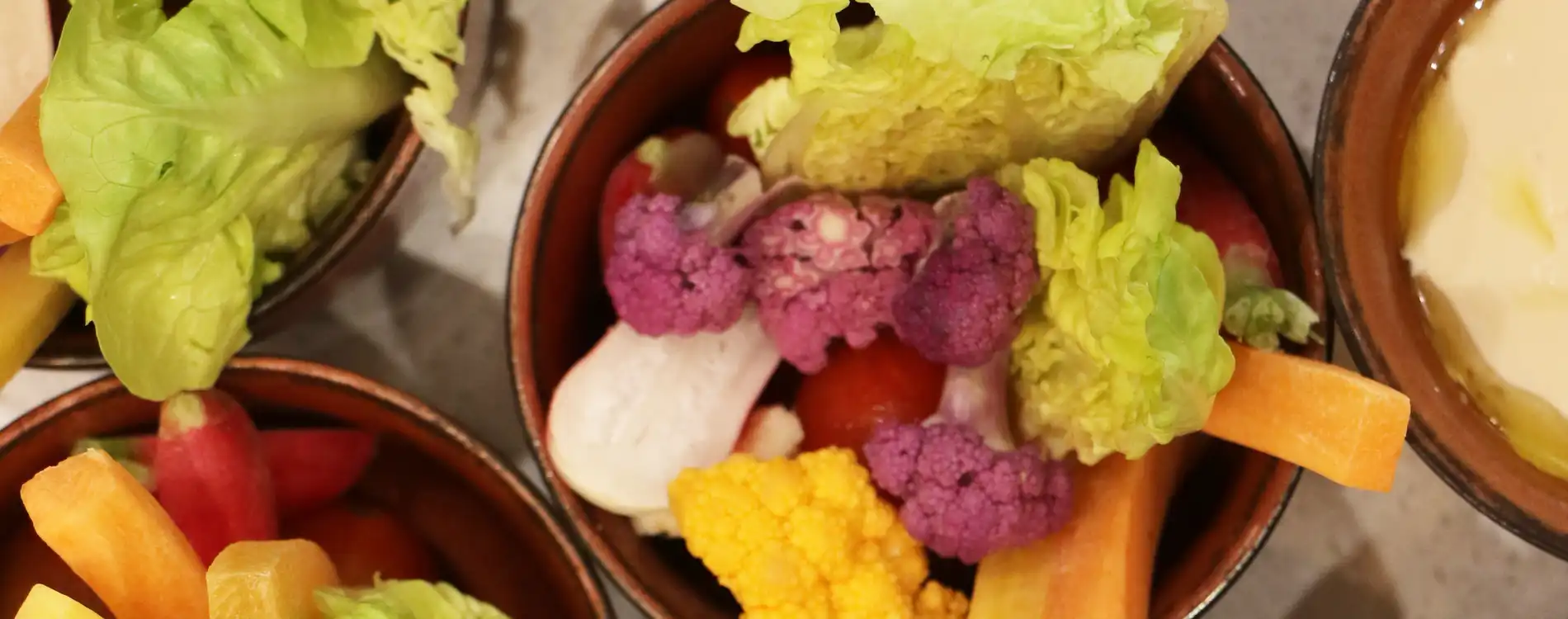Published on October 02, 2024Updated on October 16, 2024
As part of our commitment to eco-responsible cuisine, the chefs of the Groupe Monte-Carlo Société des Bains de Mer have taken up the challenge of creating original recipes featuring summer fruit and vegetables.
Contents
- Grilled aubergine with miso by Chef Vallenilla - COYA Monte-Carlo
- Gazpacho of cucumber, shredded hake with fresh herbs and stracciatella by Chef Saez Manzanares - Sporting Monte-Carlo
- Parsnips with fennel seeds and citrus with woodland aromas by Chef Panico - Monte-Carlo Beach
- Purple artichoke barigoule, creamy ricotta cheese, crunchy vegetables from the gardens of Provence, summer truffle and preserved porcini mushrooms by Chef Saez Manzanares - Sporting Monte-Carlo
- Cauliflower and red fruit tabbouleh by Chef Duby - Mada One Monte-Carlo
- Chard stalk tagliatelle with a leaf pesto by Chef Gollino - Hôtel de Paris Monte-Carlo
Grilled aubergine with miso
Miso base
- 500 g light miso paste
- 200 g sake
- 300 g mirin
- 15 g whole garlic
Miso sauce
- 200 g miso base
- 100 g honey
- 20 g ají panca
- 60 g sherry vinegar
- 50 g sesame oil
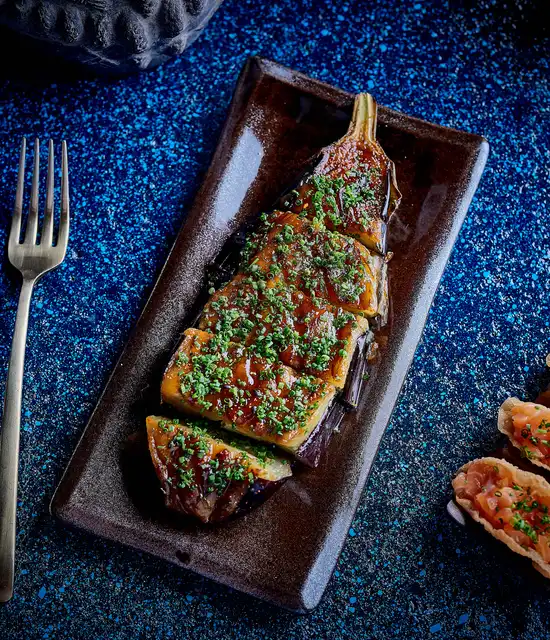
Miso base:
Place all the ingredients in a saucepan and cook over a low heat for 30 minutes.
Miso sauce:
Mix all the ingredients in a bowl with a whisk until smooth.
Cooking the aubergines:
Cut the aubergines in half and remove the excess skin from the rounded part, cutting into squares with a knife.
Salt the aubergines on both sides for 12 hours on a wire rack to remove the water.
Add a little sesame oil, then grill the aubergines on a charcoal barbecue, add the miso marinade and bake in a dry oven at 170 °C until soft.
To serve, top the aubergine with some of the marinade and caramelise it under the salamander grill. Sprinkle with togarashi, chopped chives and toasted sesame seeds.
Gazpacho of cucumber, shredded hake with fresh herbs and stracciatella
- 1 cucumber
- 150 g fresh hake fillets
- 1 lemon
- Chives
- Mint
- 100 g stracciatella
- Capers
- 4 coloured cherry tomatoes
- Olive oil
- White balsamic vinegar
- Flowers
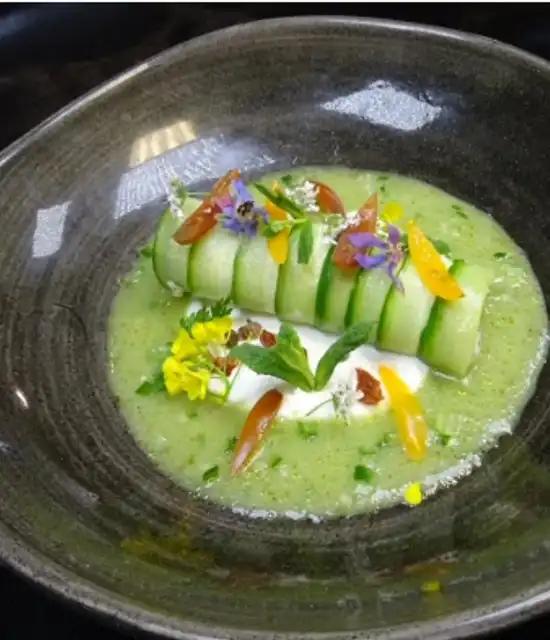
Method:
Poach the fish in a saucepan with ½ litre of water, season with salt and lemon, bring to the boil and remove from the heat. Leave to cook for about ten minutes and cool with a few ice cubes.
Wash the cucumber, then cut into 2 sections around 10 cm long. Thinly slice these sections using a mandolin. Set aside the 16 best slices to make the rolls, the 2 outer slices with skin from each section for the diced cucumber, and the rest for the gazpacho.
To make the gazpacho, blend the cucumber trimmings, a dash of balsamic vinegar, 4 mint leaves, a drizzle of olive oil, salt and pepper in a blender. Moisten with a little water and season to taste. Set aside.
Shred the hake, season with the juice of half a lemon + a grating of zest, a few sprigs of chopped chives and mint, a dash of olive oil and a twist of freshly ground pepper.
To make the rolls, place 8 slices of cucumber on a piece of cling film, place the rillette of hake on one edge and roll up tightly. Leave in the fridge for at least 30 minutes before use.
When ready to serve, arrange the stracciatella in the centre of the plate. Remove the cling film from the cucumber roll and place the roll on the stracciatella, pour the gazpacho around it, scatter the diced cucumber on top and decorate with the multicoloured tomatoes and flowers.
Parsnips with fennel seeds and citrus with woodland aromas
- 2 parsnips
- 1 orange
- ½ grapefruit
- 1 kumquat
- 1 baby fennel
- 30 g girolle mushrooms
- 2 g black truffle
- Marjoram leaf, baby basil leaves
- Extra virgin olive oil, white wine vinegar
- Salt, pepper, fennel seeds, dried fennel, shallot
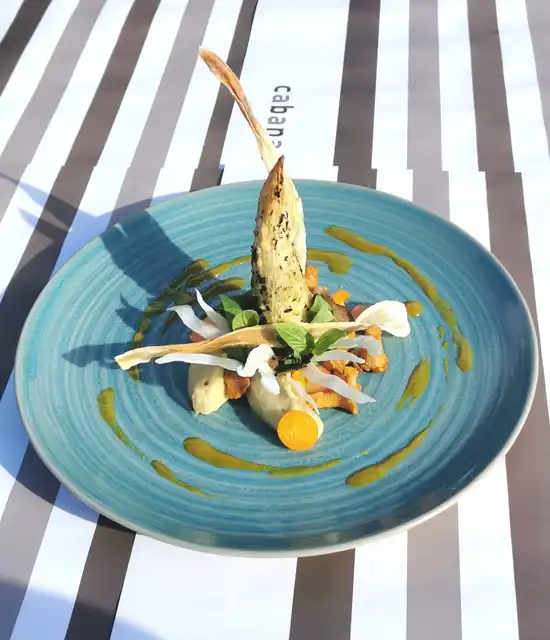
Roasted parsnips with fennel seeds:
Peel the parsnips and season with salt, pepper, extra virgin olive oil and the dried fennel. Lightly toast the fennel seeds and set aside. Bake in a dry oven at 150 °C for 1 hour.
Parsnip chips:
Peel the parsnips, use a mandolin to cut 2 thin slices of parsnip, dip in the cornflour and fry at 130 °C. Set aside.
Parsnip purée:
Chop the shallot and sweat in olive oil. Add the parsnips, cut into chunks. Add the vegetable stock, season and finish cooking. Blend in the Thermomix and set aside.
Citrus fruit:
Cut the orange and grapefruit into segments, setting aside the juice. Reduce the juice to a syrup. Set aside. Cut the segments into cubes. Slice the kumquat and make pickles.
Seasoning:
Sweat the shallot and cook the girolle mushrooms, seasoning to taste. Shred the mini fennel and set aside in the water and ice cubes. Make black truffle shavings.
Plating:
Oil the roasted parsnips and roll in the toasted fennel seeds. Reheat the parsnip purée and arrange as shown in the photo.
Purple artichoke barigoule, creamy ricotta cheese, crunchy vegetables from the gardens of Provence, summer truffle and preserved porcini mushrooms
- 2 purple artichokes
- 1 carrot with leaves
- 3 pearl onions
- 1 celery stick
- 1 lemon
- 2 multicoloured baby carrots
- 1 small fennel
- 2 round radishes
- 1 fresh porcini mushroom (60 g)
- 1 clove of garlic
- 1 shallot
- 1 summer truffle (20 g)
- Fresh seasonal herbs
- Edible flowers
- 1 slice of fresh pork fat
- 120 g ricotta
- 1 cl white wine
- Olive oil
- Vinegar
- Fine salt, freshly ground pepper
- Fleur de Sel
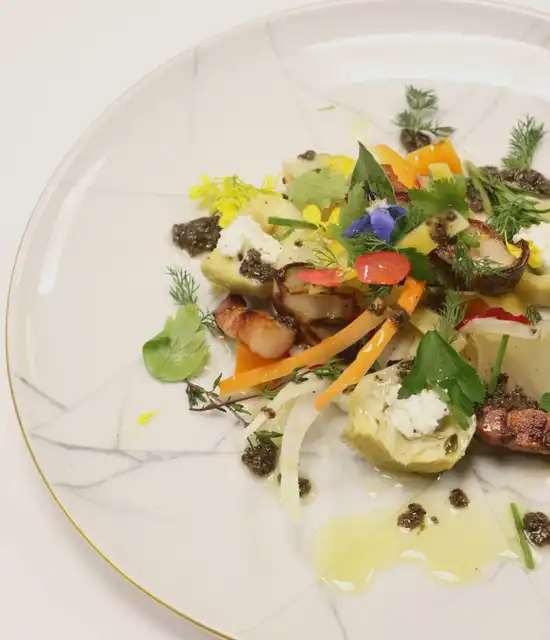
Preparing the artichokes:
Remove the hard outer leaves from around the artichoke. Cut the stem of the artichoke 2 cm from the head, then turn the knife around the artichoke following the curve of the base and strip the stem. Cut the leaves a third of the way up. Dip the artichokes in lemon water as you go. Halve the artichokes, removing the choke if necessary.
Peel and halve the onions. Strip the celery stalk and cut into small sticks. Peel the carrot. Trim and dice. Cut the slice of pork fat into 4 large, equal-sized pieces.
Heat 1 tbsp of oil in a frying pan over a low heat and add the fat, onion, celery, carrot and unpeeled garlic. Add the artichokes, then season with 1 pinch of salt and a few turns of freshly ground pepper. Fry for 2 or 3 minutes, stirring several times to coat the vegetables well with the fat. Add the thyme, bay leaves and coriander. Pour in the white wine. Leave to reduce for about 3 minutes over a medium heat.
Pour in the stock, cover and cook for around 10 minutes over a medium heat. Check that the artichokes are cooked by pricking them with the blade of a knife. There should be no resistance. Transfer the artichokes. Reduce for 1 or 2 minutes. Pour over the artichokes, drizzle with olive oil and leave to cool. Transfer.
Preparing the porcini mushrooms:
Clean the mushrooms and wash with a damp cloth. Cut into even-sized quarters. In a small frying pan, heat about 5 cl of olive oil, add a crushed, unpeeled garlic clove, then the porcini quarters, season and sauté frequently until crystallised. Remove and keep the oil and garlic. Transfer.
Preparing the vegetable shavings:
Peel the baby carrots. Clean the radishes and fennel. Cut them with a mandolin to obtain fine shavings, place them in a container with iced water and leave them for a good ¼ hour to harden. Transfer.
Strip the fresh herbs and place them in a container with iced water. Set aside. Brush the summer truffle and cut into thin strips using a mandolin. Set aside the trimmings for seasoning.
Preparing the vinaigrette:
Sweat half a finely chopped shallot in the oil from the crystallised mushrooms, along with the chopped garlic. When they are translucent, remove from the heat and stir in the chopped truffle trimmings, then transfer to a small bowl. Season with fine salt, freshly ground pepper and a dash of good vinegar. Add more olive oil if necessary.
Plating:
Spoon a generous amount of ricotta in the centre of the plate and flatten slightly.
Arrange the 3 artichoke halves on top, then top with the remaining ricotta and place the artichoke cooking mixture (onion, celery, carrot, pork fat) around them.
Arrange the drained vegetable shavings and crystallised porcini mushrooms harmoniously.
Drizzle the artichokes with the reduced barigoule jus to taste, then season them with the truffle vinaigrette. Sprinkle with a little fleur de sel and freshly ground pepper.
Garnish with the fresh herbs and a few flower petals.
Cauliflower and red fruit tabbouleh
- Bulgur wheat
- 1 cauliflower
- Mint
- Coriander
- Parsley
- Pomegranate
- Lemon
- Sumac
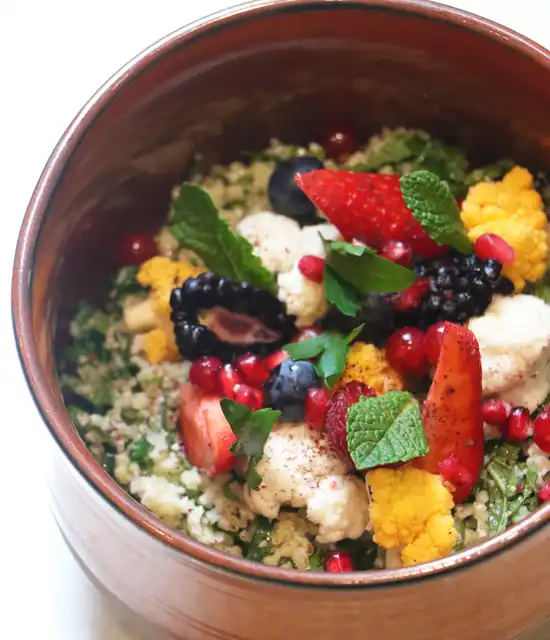
Method:
Start by cooking the bulgur wheat in simmering salted water for 11 minutes.
While the bulgur wheat is cooking, cut the cauliflower florets into small pieces and set the coloured florets aside. Remove the white ones and blend them gently in a blender until the texture resembles bulgur wheat.
Finely chop the herbs (mint, coriander and parsley).
Vinaigrette:
Place the pomegranate molasses, lemon juice, salt, pepper and sumac in a mixing bowl and stir to combine. Make a mixture of ½ olive oil and ½ grape seed oil, then pour over the mixture to emulsify the vinaigrette.
Plating:
Once the bulgur wheat has cooled, mix with the mixed cauliflower florets, using 2 tablespoons of cauliflower for every tablespoon of bulgur wheat. Add the herbs and season with the vinaigrette.
To finish, place the mixture on the plate and top the tabbouleh with the remaining cauliflower florets and the red fruit. To complete the decoration, sprinkle the tabbouleh with coriander, mint and parsley leaves.
Chard stalk tagliatelle with a leaf pesto
Chard:
- 1 large bunch of chard stalks
- 40 cl vegetable stock
- 40 g butter
- 4 cl lemon juice
- Salt to taste
Pesto :
- 150 g chard greens
- 1 bunch basil
- 40 g maritime pine nuts
- 50 g parmesan
- ½ clove garlic
- 10 cl olive oil
- 2 cl lemon juice
- Salt to taste
- Freshly ground pepper to taste
To finish:
- 20 g maritime pine nuts
- ¼ bunch basil
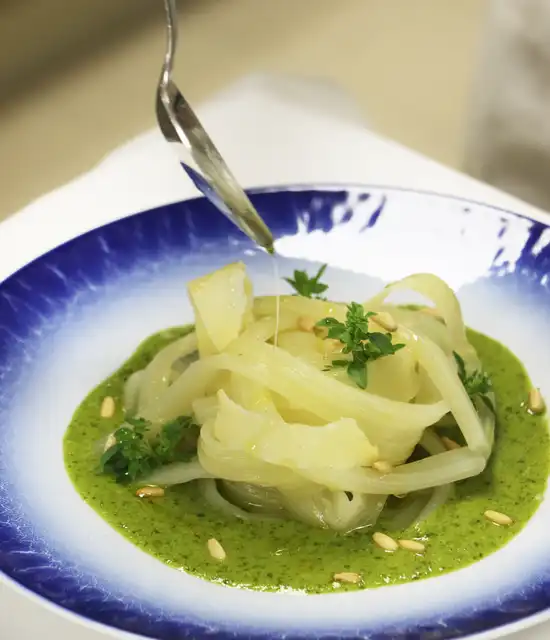
Preparing the chard stalk tagliatelle:
Separate the chard stalks from the chard greens, reserving the leaves for making the pesto.
Trim the stalks and cut into rectangles 20 cm long and 4 cm wide. Cut them in half lengthways. Cut into 1 cm wide strips to make “tagliatelle”, and dip in slightly lemony water. Drain and set aside in the fridge.
Making the pesto:
Peel and de-germ the half clove of garlic. Remove the leaves from the bunch of basil. Grate the Parmesan. Roast the pine nuts on a baking tray in the oven at 130 °C for 15 minutes. Remove and leave to cool to room temperature. Remove the large veins from the chard greens. Bring a pan of salted water to the boil. Blanch the greens for 1 min, then cool in a bowl of iced water. Drain and press. Place the chard greens and basil in a blender and blend to a smooth, green purée. Transfer the purée into another recipient. In the same blender bowl (without rinsing), blend together the pine nuts, the half clove of garlic and the grated parmesan until smooth. Add the green purée to this mixture. Add the juice of half a lemon, then pour in the olive oil a little at a time while blending to emulsify the pesto. Season with salt and freshly ground pepper. Set aside in the fridge.
Finishing & presentation:
Roast the pine nuts on a baking tray in the oven at 130 °C for 15 minutes. Remove and leave to cool to room temperature. Remove 12 basil heads and set aside in a cool place. Bring a pan of salted water to the boil. Heat the vegetable stock in a frying pan and add the butter. Reduce to a glazed consistency, then acidify with a dash of lemon juice. Meanwhile, plunge the chard tagliatelle into salted water and cook at a simmer for 10 to 12 minutes, drain and roll in the glaze to coat them. Arrange the pesto at the bottom of the plate, place a nest of tagliatelle on top and add 3 fresh basil heads. Sprinkle with a few roasted pine nuts.
You might also like…
Marlow : so chic, so british
Discover the warm and sophisticated new Marlow café-lounge, in the heart of the new Mareterra seafront district.

Institut audiovisuel de Monaco
Based on the Boulevard du Jardin Exotique, this repository stores over 100,000 audio documents
and almost 500,000 photos of the Principality and the Riviera. Treasures.

Monte-Carlo Cigar Club
Dominique London, a leading light in the luxury cigar world, is teaming up with Monte-Carlo Société des Bains de Mer
to open the Monte-Carlo Cigar Club in 2025. This exclusive new venue promises to be an icon in the making.

